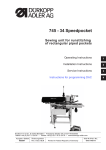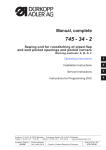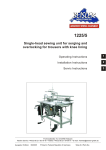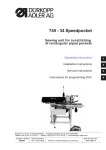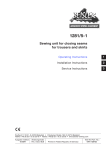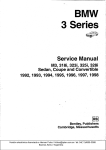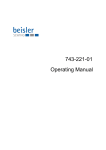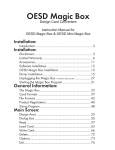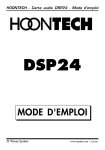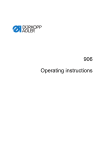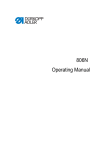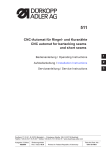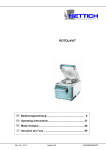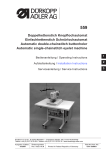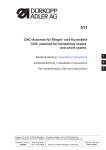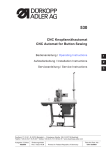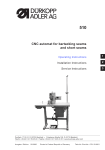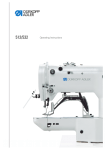Download Beisler 100 Technical data
Transcript
100 - 69 Operating manual All rights reserved. Property of Dürkopp Adler AG and protected by copyright. Reproduction or publication of the content in any manner, even in extracts, without prior written permission of Dürkopp Adler AG, is prohibited. Copyright © Dürkopp Adler AG - 2013 Table of contents 1 About this operating manual ..................................................... 3 1.1 1.2 1.3 1.4 1.5 1.5.1 1.5.2 Scope of application of the operating manual............................... 3 For whom is this operating manual?............................................. 3 Conventions of representation– Symbols and characters ............ 4 Other documents .......................................................................... 4 Liability.......................................................................................... 4 Transportation............................................................................... 5 Designated use............................................................................. 5 2 Performance description ........................................................... 7 2.1 2.2 2.3 2.4 3 Features........................................................................................ 7 Declaration of conformity .............................................................. 8 Optional equipment....................................................................... 9 Technical data ............................................................................ 13 Safety instructions ................................................................... 15 3.1 3.2 4 Basic safety instructions ............................................................. 15 Signal words and symbols used in warnings .............................. 16 Machine description 100-69..................................................... 19 4.1 4.2 5 Sewing unit ................................................................................. 19 Software description ................................................................... 20 Operation................................................................................... 21 5.1 5.1.1 5.1.2 5.2 5.3 5.4 5.4.1 5.4.2 5.5 5.6 5.7 5.8 5.8.1 5.8.2 5.9 5.9.1 5.9.2 5.9.3 5.9.4 5.9.5 5.10 5.11 5.11.1 5.11.2 5.11.3 5.11.4 5.11.5 5.11.6 5.11.7 5.12 5.12.1 5.12.2 Working methods........................................................................ 21 Working method "Production of trousers"................................... 22 Working method “Breast welt pocket"......................................... 24 Swing the folding station aside. .................................................. 26 Removing the fabric sliding sheet............................................... 28 Needles and threads................................................................... 29 Recommended yarns.................................................................. 29 Changing the needles................................................................. 31 Threading in the needle thread................................................... 32 Winding on the looper thread...................................................... 33 Residual thread monitor.............................................................. 34 Slanted pocket opening (optional) .............................................. 35 Swinging the corner knife station out / in ................................... 35 Setting the corner knife............................................................... 37 Sewing procedure....................................................................... 38 Switching on ............................................................................... 38 Reference position...................................................................... 39 Starting the sewing cycle ............................................................ 40 EMERGENCY stop..................................................................... 40 Switching off ............................................................................... 41 Quick clamp adjustment/folder monitoring.................................. 41 Functions/operation of the optional equipment........................... 43 Tape feed unit............................................................................. 43 Device for endless zippers.......................................................... 45 Downholder and Pocket bag clamp ............................................ 46 Stacker........................................................................................ 47 Roll-off device ............................................................................. 51 Blow-out device .......................................................................... 52 Bundle clamp .............................................................................. 53 Maintenance ............................................................................... 55 Cleaning...................................................................................... 55 Oil level control ........................................................................... 57 Operating manual 100-69 version 00.0 - 05/2013 1 Table of contents 2 6 Set-up......................................................................................... 59 6.1 6.2 6.2.1 6.2.2 6.2.3 6.3 6.3.1 6.3.2 6.3.3 6.3.4 6.4 6.4.1 6.4.2 6.4.3 6.4.4 6.4.5 68 6.5 6.6 6.7 6.8 6.9 6.10 7 Delivery scope ............................................................................ 59 Installing the sewing unit............................................................. 60 Transportation............................................................................. 60 Removing the transport securing devices................................... 61 Setting the working height .......................................................... 62 Attaching the machine parts removed for shipping..................... 63 Attaching the thread reel holder.................................................. 63 Mounting the control panel ......................................................... 63 Fixing the winder......................................................................... 64 Table extensions (optional equipment)....................................... 64 Electrical connection................................................................... 66 Connecting the control panel DACIII .......................................... 66 Connecting a separate winder .................................................... 67 Checking the nominal voltage and connecting to the mains....... 67 Checking the nominal voltage of the vacuum device.................. 68 Direction of rotation of the sewing motor and the vacuum blower .. Pneumatic connection ................................................................ 69 Conncetion to the in-house vacuum unit .................................... 71 Oil lubrication .............................................................................. 72 Putting into operation.................................................................. 73 Installation of the software .......................................................... 75 Customer service........................................................................ 77 Decommissioning..................................................................... 79 8 Disposal..................................................................................... 81 Operating manual 100-69 version 00.0 - 05/2013 About this operating manual 1 About this operating manual The operating manual for the 100-69 sewing unit was compiled with the utmost care. It contains information and notes in order to make long-term and reliable operation possible. Should you notice any discrepancies or if you have improvement requests, then we would be glad to receive your feedback, chapter 6.10 Customer Service. Please regard the operating manual as part of the product and keep it in a safe place where it can be easily accessed. Read the operating manual completely prior to using the unit for the first time. Only pass the product on to third parties together with the operating manual. 1.1 Scope of application of the operating manual This operating manual describes the set-up and intended use of the 100-69 sewing unit. 1.2 For whom is this operating manual? The operating manual is intended for: • Machine operaters: This group of employees has been trained in operating the machine and can access the operating manual. Specifically chapter 5 of the Operating Manual is important for this group of employees. • Technicians: This group of employees has the appropriate technical training allowing them to perform maintenance on the sewing unit or to repair faults. Specifically chapter 6 of the Set-up Instructions is important for this specialized staff. Service instructions are supplied separately. With regard to minimum qualification and other requirements to be met by the personnel, please also observe chapter 3 of the Safety Instructions. Operating manual 100-69 version 00.0 - 05/2013 3 About this operating manual 1.3 Conventions of representation– Symbols and characters Different information is depicted or highlighted in this operating manual by the following characters for easier and quicker understanding: Symbol/character • Meaning Lists are identified by bullet points. 1. Instructions are numbered and have to be performed in the specified order. 2. References to further information in this operating manual or other documents are identified by this symbol. Safety Important warnings for the user of the machine are specifically marked. Because safety constitutes an area of major importance, hazard symbols, levels of risk, and their signal words are described separately in chapter 3 of the Safety Instructions. Location Information on where something is positioned using the terms "right" or information "left" must always be regarded from the operator's point of view if the fig- ure gives no other obvious indication for determining the location. 1.4 Other documents The device contains built-in components from other manufacturers. The respective manufacturers have carried out hazard assessments for these purchased parts and confirmed compliance of the design with the applicable European and national regulations. The intended use of the built-in components is described in the corresponding manuals of the manufacturers. 1.5 Liability All information and notes in this operating manual have been compiled in accordance with the latest technology and the applicable standards and regulations. The manufacturer cannot be held liable for any damage due to: • Damage during transport • Failure to observe the operating manual • Improper use • Unauthorized modifications to the machine • The deployment of untrained personnel • Using spare parts not approved 4 Operating manual 100-69 version 00.0 - 05/2013 About this operating manual 1.5.1 Transportation Dürkopp Adler cannot be held liable for any damage during transport. Check the delivered product immediately after receiving it. Report any damage to the last transport manager. This also applies if the packaging is not damaged. Keep the machines, devices and packaging material in the condition they were at the time when the damage was identified. That secures any claims towards the transport company. Report all other complaints to Dürkopp Adler immediately after receiving the product. 1.5.2 Designated use The Beisler 100-69 is a sewing unit designated for the sewing of light to medium-weight material. Such material is generally made of textile fibers, composite materials but it may also consist of leather. These materials are used in the garment industry. In general only dry material must be sewn on this machine. The material must not contain any hard objects. The seam is generally sewn with core thread, polyester fiber or cotton thread. The dimensions for needle and hook threads can be taken from the table in chapter 5.4. Before using any other threads it is necessary to estimate the consequential dangers and to take the respective safety measures, if required. The machine may only be set up and operated in dry conditions on wellmaintained premises. If the machine is operated on premises that are not dry and well-maintained, then further measures may be required which must be compatible with EN 60204-31:1999. Only authorized/trained persons may work on the machine. The manufacturer will not be held liable for damage resulting from improper use. WARNING Danger due to high voltage, crushing and sharp objects. Improper use can result in injuries. Please follow all instructions given in the manual. ATTENTION Improper use could result in material damage. Please follow all instructions given in the manual. Operating manual 100-69 version 00.0 - 05/2013 5 About this operating manual 6 Operating manual 100-69 version 00.0 - 05/2013 Performance description 2 Performance description The 100-69 is a sewing unit for the runstitching of piped pocket, flap pocket and welt pocket openings with rectangular or slanted pocket corners. 2.1 Features The Beisler 100-69 is a sewing unit for automated runstitching of piped pocket, flap pocket and welt pocket openings with rectangular or slanted pocket corners. The slanted pocket corners result from the offset of the two seam rows. It is possible to sew different slants at the seam beginning and at the seam end. Depending on the working method different feeding devices, corner knife stations and optional equipments are used. Machine head • • • • • • • • Twin needle lockstitch version Needle bars can be switched separately Vertical hook Externally driven center knife, speed and circuit timing programmable Thread trimming device for needle and hook threads Needle thread monitor Photoelectric remaining thread monitor for the hook threads DC direct sewing drive Step motors for the material feed and the length adjustment of the corner trimming device The step motor technology allows short machine times and guarantees an absolutely precise material feed and accurate corner incisions. Thus, it contributes to an unequalled pocket quality combined with high productivity. New control generation “DAC III” The graphic user guidance exclusively occurs via internationally comprehensible symbols and text lines in the corresponding language. The various symbols are combined in groups within the menu structure of the sewing and test programs. The user-friendly operation cuts short training times. 20 storage locations with each 6 seam programs are available. Thus it is possible to generate and store up to 6 different seam programs per storage location. Each storage location can memorize up to 6 sewing programs in any order that will be sewn in sequence. All relevant slants can be programmed by the operator via parameters. Operating manual 100-69 version 00.0 - 05/2013 7 Performance description The comprehensive test and monitoring system MULTITEST is integrated in the DAC. A microcomputer does the control tasks, supervises the sewing process and indicates operating errors and malfunctions in the display. Optional equipment Due to a flexible system of optional equipment the sewing unit can be optimally adapted to the respective application at low cost. Sewing equipment and folders Please see the 100-69 parts list for details concerning sewing equipment and folders for the various applications or contact the Beisler company. 2.2 Declaration of conformity The machine complies with the European regulations specified in the declaration of conformity or in the installation declaration. 8 Operating manual 100-69 version 00.0 - 05/2013 Performance description 2.3 Optional equipment Due to a flexible system of optional equipment the sewing unit can be optimally adapted to the respective application at low cost. = Standard equipment Optional equipment 100-69 (slanted pocket) Order No. 100-69 (rectangular pocket) = optional extension Knife bracket kits B169 590014 Kit rectangular pocket This kit contains the knife bracket and the sewing head for rectangular pockets B169 590024 Kit slanted pocket This kit contains the knife bracket and the sewing head for rectangular and slanted pockets Stacking devices 1970 593144 Throw-over stacker To be position near the machine for stacking to the side. 0745 427524 Universal stacking device (grip stacker) To be positioned for stacking to the side. 1970 593194 Bundle clamp (incl. table) For the bundling of trousers parts 0745 597604 Blow-out device For blowing out the finished workpieces 0745 597954 Roll-off device The roll-off device is used to transport short pieces into the stacker or to eject the pieces to be processed. The speed and the working cycle of the roll-off device can also be programmed. 1970 593414 Cutter with pull-off device Device for the processing of endless zippers Only to be deployed in conjunction with the folders RV 1970 595564 – 1970 595704. 1970 593444 Zipper guide stop for single and double piping (Interior or exterior pocket processing, manual positioning of the trimmed zipper) Zipper feeders Operating manual 100-69 version 00.0 - 05/2013 9 Optional equipment 100-69 (slanted pocket) Order No. 100-69 (rectangular pocket) Performance description Breast welt processing B169 590094 Kit breast welt processing Consists of flap clamp for the breast welt processing, second photocell rotatable to the left, as well as 5 laser marking lamps with attachments. (only in conjunction with the kit slanted pockets 1970 596944, rapid clamp adjustment left 1970 593154 and clamp set 200 mm B169 590034) Laser add-on kits 0745 598144 Two-pack laser add-on kit For extending the standard 3 laser marking lamps to a maximum of 5 laser marking lamps. For an easy replacement the laser lights are equipped with a short cable and a plug. 0745 597934 Three-pack laser add-on kit For extending the existing 5 laser marking lamps to 8 laser marking lamps. An extension to 16 switchable laser lights is possible (additional cable 0745 597974 and PCB 9850 001073 needed). For an easy replacement the laser lights are equipped with a short cable and a plug. 1970 593104 Rest table (small) Size about 450mm x 700mm 1970 593114 Rest table (large) Size about 600mm x 800mm Second photocell Second photocell for the automatic flap scanning (for the alternating processing of jackets and trousers switchable via program) Vacuum device For an exact positioning of the workpieces, to be connected to the in-house vacuum unit Remark: If there is no in-house vacuum unit, a vacuum generator has to be ordered additionally. Trays Light barriers B169 590114 Vacuum B169 590084 10 Operating manual 100-69 version 00.0 - 05/2013 1970 593314 Optional equipment Vacuum (side channel blower) For an exacte positioning of the workpieces without inhouse vacuum unit, a side channel blower can be adapted into the stand. 100-69 (slanted pocket) Order No. 100-69 (rectangular pocket) Performance description Miscellaneous 0745 598134 Sewing light with transformer 0745 598254 Set of castors Set of transport castors in order to move the sewing unit without external appliances. B169 590074 Tape feed automatic cutting (driven by step-motor) Automatic feeding and cutting of a reinforcement strip pulled from a roll. Start time and cutting time can be programmed corresponding to the pocket. 1970 593154 Pneumatic clamp adjustment left For an automatic adjustment of the left clamp when changing the folder 1970 593164 Pneumatic clamp adjustment right For an automatic adjustment of the right clamp when changing the folder 1970 593214 Special clamp (sandwich clamp) Special clamp feed system for difficult materials (needed for piped pockets in car seats, articles made from leather or synthetic materials) Only for needle distances of 10 an 12 mm. Not combinable with the tape feed. 1970 593334 Shaped guide lining loop triangle 90° processing of interior jacket pockets 1970 593344 clamp stop Clevis clamp stop for button hole strap (processing of trousers) 1970 593364 Blow-out device left For the blowing on of the piping with large piping projections 1970 593374 Blow-on device right For the blowing on of the piping with large piping projections B169 590104 Downholder and Pocket bag clamp Downholder for the smoothing out of the fullness caused by the darts with a clamping device for the pocket bags. Operating manual 100-69 version 00.0 - 05/2013 11 Optional equipment 100-69 (slanted pocket) Order No. 100-69 (rectangular pocket) Performance description Clamps 12 B169 590034 Set of clamps 200 mm Universal clamp right with folding plate, without flap clamp for jackets, trousers and linings. Seam length without flap 200 mm, with flap 180 mm. B169 590044 Flap clamp right for 200 mm clamp (max seam length with flap 180 mm) B169 590054 Flap clamp left for 200 mm clamp (max seam length with flap 180 mm) B169 590064 Set of clamps 240 mm Contains right and left clamp for a seam length of 240 mm without flap and 220 mm with flap. Includes right and left flap clamp. Operating manual 100-69 version 00.0 - 05/2013 Performance description 2.4 Technical data Technical data 100-69 Sewing stitch type 301/Double lockstitch Number of needles 2 Needle system 2134-85 Needle size: [Nm] 80-100 Number of stitches (programmable) [min-1] 3000 Number of stitches at factory setting: [min-1] 2500 Stitch length (programmable) [mm] 0.5-3,0 Number of condensed stitches [n] (programmable) 1-10 Number of bartack stitches [n] (programmable) 0-5 Seam distance [mm] 4.8, 8, 10, 12, 14, 16, 18, 20, 22, 24, 26, 30 Pocket length [mm] 20-200 (240 mm optional) maximum seam offset [mm] +/- 13 Operating pressure [bar] 6 Air consumption per working cycle about [NL] 5 Height of table without castors [mm] - min - max 797 1076 Height of table with castors [mm] - min - max 859 1138 Length, width, height [mm] Weight [kg] Nominal voltage [V] Frequency [Hz] Operating manual 100-69 version 00.0 - 05/2013 1440, 780, 1200 about 280 (depending on equipment) 1 x 190-240 50/60 13 Performance description 14 Operating manual 100-69 version 00.0 - 05/2013 Safety instructions 3 Safety instructions This section contains basic instructions for your safety. Read the instructions carefully before setting up or operating the machine. Make sure to follow the information included in the safety instructions. Failure to do this can result in serious injury and damage to the machine. 3.1 Basic safety instructions The machine may only be used as described in this operating manual. The operating manual must be available at the machine's location at all times. Work on live components and equipment is prohibited. Exceptions are defined in the specifications in DIN VDE 0105. For the following work, the machine must be disconnected from the power supply using the main switch or by disconnecting the power plug: Replacing the needle or other sewing tools Leaving the workplace Performing maintenance work and repairs Incorrect or defective spare parts could impair safety and damage the machine. Therefore only use original spare parts from the manufacturer. Transportation When the machine is being transported, use a lifting carriage or a forklift. Raise the machine max. 20 mm and secure it against slipping off. Set-up The connecting cable must have a power plug approved in the specific country. The power plug may only be connected to the power cable by a qualified specialist. Operator's Observe the country-specific safety and accident prevention regulations obligations and the legal regulations concerning industrial safety and the protection of the environment . All warnings and safety signs on the machine must always be in legible condition and must not be removed. Missing or damaged labels have to be replaced immediately. Operating manual 100-69 version 00.0 - 05/2013 15 Safety instructions Requirements to The machine may only be set up by qualified specialists. be met by the personnel Maintenance work and repairs may only be carried out by qualified specialists. Work on electrical equipment may only be carried out by qualified specialists. Only authorized persons may work on the machine. Every person who works on the machine must have read the operating manual first. Operation Inspect the machine while in use for any externally visible damage. Inter- rupt your work if you notice any changes to the machine. Report any changes to your supervisor. A damaged machine must not be used any more. Safety devices Safety equipment must not be removed or put out of service. If this cannot be avoided for a repair operation, the safety equipment has to be refitted and put back into service immediately afterwards. 3.2 Signal words and symbols used in warnings Warnings in the text are distinguished by color bars. The color scheme is oriented towards the severity of the danger. Signal words specify the severity of a danger: Signal words Signal words and the endangerment that they describe: Signal word DANGER Resulting in death or serious injury. WARNING Death or serious injury possible. CAUTION Moderate to minor injuries possible. ATTENTION 16 Endangerment Damage possible. Operating manual 100-69 version 00.0 - 05/2013 Safety instructions Symbols In the case of dangers to personnel, the following symbols indicate the type of hazard: Symbol Type of danger General danger Danger due to electric shock Danger due to sharp objects Danger due to crushing Examples Examples of the layout of the warnings in the text: DANGER Type and source of the danger Consequences in the event of noncompliance Measures for avoiding the danger This is what a warning looks like for a hazard that will result in serious injury or even death if not complied with. WARNING Type and source of the danger Consequences in the event of noncompliance Measures for avoiding the danger This is what a warning looks like for a hazard that could result in serious injury or even death if not complied with. Operating manual 100-69 version 00.0 - 05/2013 17 Safety instructions CAUTION Type and source of the danger Consequences in the event of noncompliance Measures for avoiding the danger This is what a warning looks like for a hazard that could result in moderate or minor injury if the warning is not complied with. ATTENTION Type and source of the danger Consequences in the event of noncompliance Measures for avoiding the danger This is what a warning looks like for a hazard that could result in material damage if not complied with. ATTENTION Type and source of the danger Consequences in the event of noncompliance Measures for avoiding the danger This is what a warning looks like for a hazard that could result in environmental damage if not complied with. 18 Operating manual 100-69 version 00.0 - 05/2013 Machine description 100-69 4 Machine description 100-69 The 100-69 is a sewing unit for the runstitching of piped pocket, flap pocket and welt pocket openings with rectangular or slanted pocket corners. The correct operating principle involves a sequence of different steps and requires precise knowledge of all operating controls. 4.1 Sewing unit The illustration below shows the sewing unit 100-69. Fig. 1: Complete overview of the 100-69 Operating manual 100-69 version 00.0 - 05/2013 19 Machine description 100-69 4.2 Software description The software and all its setting possibilities is explained in detail in the Programming instructions. The Programming ínstructions are available together with the Service Instructions. At this point only a short overview of the control panel with its keys and corresponding functions is added. Fig. 2: Control panel of the 100-69 ུ ཱི ི ཱ (1) - Color display (2) - Escape key (3) - OK key (4) - Cursor key (5) - Icon indicating the function Key groups and their function: Key/keygroup Icons indicating the function 20 Function Directly select function/parameter. Cursor keys Select function/parameter. ,: Select icon the of requested function/parameter , : Switch the function/parameter on and off, select the previous/next parameter value level, activate the test program Escape key Display the former value again. OK key • Open the window for the setting of the selected function/parameter. • Adopt the set value. Operating manual 100-69 version 00.0 - 05/2013 Operation 5 Operation The Beisler 100-69 is a sewing unit for the runstitching of piped pocket, flap pocket and welt pocket openings with rectangular or slanted pocket corners. Fault-free operation is necessary in order to achieve a good sewing result. In order to achieve this, all relevant operations on the 100-69 will be explained below. 5.1 Working methods DANGER Danger of being crushed! Do not reach under the downholder, the feeding clamp and the folder during the positioning process. ATTENTION Material damage! The steps of the positioning process are dependent on the equipment of the respective sewing unit. Thus, the positioning steps described in the examples only apply for sewing units with identical equipment. The individual working methods for trousers and men's jackets are described on the following pages. The description is structured as follows: Feeding positions This item indicates the feeding points for the different workpieces (e.g. left and right parts). Aligning the positioning aids Here you will find a description how to adjust and align the positioning aids (e.g. positioning marks, marking lamps, guides etc.). Feeding and starting the sewing process The steps of the feeding process are dependent on the equipment of the respective sewing unit. Operating manual 100-69 version 00.0 - 05/2013 21 Operation 5.1.1 Working method "Production of trousers" Possible processing variants • Front trousers pockets with underlaid pocket bag. • Hind trousers pockets with or without flap, with underlaid pocket bag. • Hind trousers pockets with or without flap, with automatically fed reinforcement strip. Positioning method Example: Hind trousers without flap, with pocket bag positioned underneath Fig. 3: Production of trousers 1st step ཱ (1) - Pocket bag clamp (2) - Markings 1st step: 1. Select the pocket program at the control panel. 2. Push the pocket bag under the pocket bag clamp (1) and position it at the markings (2). For example adhesive strips fitted on the fabric sliding sheet may serve as markings. 22 Operating manual 100-69 version 00.0 - 05/2013 Operation Fig. 4: Production of trousers 2nd step ི ཱི ུ (3) - Fabric downholder (4) - Marking (5) - Center positioning point 2nd step: 1. Position the hind trousers at the center positioning point (5) and the marking (4). 2. Actuate the central foot switch. The hind trousers is clamped by the fabric downholder (3) in its position. 3. Smooth out the clamped hind trousers in the dart area. 4. If the machine is additionally equipped with vacuum: Actuate the left foot switch. The vacuum is switched on. Fig. 5: Production of trousers 3rd step ཱུ ྲྀ ཷ (6) - Folder (7) - Piping strip (8) - Front edge 3rd step: 1. Step on the central pedal. The transport clamps move to the front and lower on the workpiece. 2. Position the piping strip (7) on the feeding clamps flush with the front edges (8). Operating manual 100-69 version 00.0 - 05/2013 23 Operation A detailed description of the alignment of the different types of piping on the feeding clamp follows. See “Positioning of piping strips”. 3. Actuate the central foot switch. The folder (6) lowers. 4. Actuate the central pedal once again. The sewing cycle starts. 5.1.2 Working method “Breast welt pocket" Sewing patterned or plain goods When processing plain goods without pattern it is not necessary to align jacket front part and breast welt as per pattern. This results in a faster working method for plain goods. • Aligning the positioning aids Positioning method Example: Men's jacket front part with breast welt pocket, patterned Fig. 6: Breast welt pocket 1st step ཱ ི (1) - Laser marking (2) - Breast welt (3) - Laser marking 1st step: 1. Select pocket program No. 7 at the control panel. 2. Position breast welt (2) on the jacket front as per the stripes. 3. Align the breast welt of the jacket front at the laser markings (1) and (3) (right and transversal laser). 4. Step on the start pedal. The vacuum is switched on. The jacket front is aspirated. 24 Operating manual 100-69 version 00.0 - 05/2013 Operation Fig. 7: Breast welt pocket 2nd step ཱི ུ ཱུ ྲྀ ཷ ླྀ (4) - Left marking (5) - Pocket bag (6) - Flap clamp (7) - Breast welt (8) - left clamp (9) - right clamp 2nd step: 1. Remove the breast welt (7). 2. Position the pocket bag (5) at the left laser (4). 3. Step on the central pedal. The fabric clamps move to the front. The right clamp (9) clamps the jacket front. The left clamp (8) remains without pressure Fig. 8: Breast welt pocket 3rd step ཹ (10) - Seam allowance Operating manual 100-69 version 00.0 - 05/2013 25 Operation 3rd step: 1. Position the breast welt (7) at the stop of the left fabric clamp (at the front laser). 2. Fold back the seam allowance (10) at the clamp and check the course of the pattern in longitudinal direction. Correct the course of the pattern by slightly pulling the jacket front or by shifting the flap clamp (6). 3. Step on the central pedal. Pressure is applied on the left fabric clamp (8). 4. Actuate the central pedal. The folder lowers. 5. Actuate the central pedal once again. The sewing cycle starts. 5.2 Swing the folding station aside. ATTENTION Material damage! After being swung back the folding station must click into lock (1). For interventions at the sewing point (threading the needle threads, needle change etc.) the entire folding station with folder and laser lamps can be swiveled to the right. Fig. 9: Folding station swung out ཱ (1) - Lock/knob 26 (2) - Folding station Operating manual 100-69 version 00.0 - 05/2013 Operation 1. Pull the lock (1) upwards. 2. Swing the complete folding station (2) with folder to the right. The sewing point is freely accessible. With the sewing unit switched on, a safety message appears on the screen of the control panel. Fig. 10: Safety message Swinging the folding station back Swing back the folding station (2) until lock (1) clicks into place. Fig. 11: Folding station lock (1) - Lock/knob Operating manual 100-69 version 00.0 - 05/2013 27 Operation 5.3 Removing the fabric sliding sheet DANGER Risk of injury Turn the main switch off. Remove the fabric sliding sheet only with the sewing unit switched off. Changing the hook thread bobbins: 1. Turn the main switch off 2. Lift the fabric sliding sheet (2) in the area of the recess (1) on the table top and swing it to the left. Fig. 12: Removing the fabric sliding sheet (1) - Recess on table top 28 ཱ (2) - Fabric sliding sheet Operating manual 100-69 version 00.0 - 05/2013 Operation Removing the hook thread bobbins (for maintenance work and adjustments): 1. Turn the main switch off 2. Completely lift the fabric sliding sheet at the rear pin (3). Fig. 13: Completely removing the fabric sliding sheet ི (3) - Pin 5.4 Needles and threads In order to achieve the optimal sewing result, the appropriate needles and yarns should be employed. 5.4.1 Recommended yarns Needle system 2134-85 Recommended needle size Nm 90 for thin material Recommended needle size Nm 100 for medium-weight material Recommended needle size Nm 110 for heavy-weight material High sewing security and good sewability are achieved with the following core threads: • Two-ply polyester endless polyester core-spun(e.g. Epic Poly-Poly, Rasant x, Saba C, ...) • Two-ply polyester endless cotton core-spun(e.g. Frikka, Koban, Rasant, ...) If these threads are not available, the polyester fibre or cotton threads listed in the table can also be sewn. Operating manual 100-69 version 00.0 - 05/2013 29 Operation Often two-ply core threads are offered by the thread manufacturers with the same designation as three-ply polyester fibre threads (3cyl.-spun). This causes uncertainty with regard to twisting and thread thickness. When in doubt, unravel the thread and check whether it is twisted 2- or 3-ply. The label no. 120 on the thread reel of a core thread corresponds e.g. to the thread size Nm 80/2 (see table values in brackets). In case of monofilament threads you can use needle threads and hook threads of the same thickness. The best results are achieved with soft and elastic threads (software) of the thread thickness 130 Denier. Recommended thread thicknesses: Needle size Nm Core thread Needle thread Hook thread Needle thread Hook thread Polyester endless Label no. Polyester spun Label no. Polyester endless Label no. Cotton spun Label no. 90 120 (Nm 80/2) 120 (Nm 80/2) 120 (Nm 80/2) 120 (Nm 80/2) 100 100 (Nm 65/2) 100 (Nm 65/2) 100 (Nm 65/2) 100 (Nm 65/2) 110 75 (Nm 50/2) 75 (Nm 50/2) 75 (Nm 50/2) 75 (Nm 50/2) Needle size Nm 30 Core thread Polyester fibre thread (3cycl.-spun) Cotton thread Needle thread Hook thread Needle thread Hook thread 90 Nm 80/3-120/3 Nm 80/3-120/3 NeB 50/3-70/3 NeB 50/3-70/3 100 Nm 70/3-100/3 Nm 70/3-100/3 NeB 40/3-60/3 NeB 40/3-60/3 110 Nm 50/3-80/3 Nm 50/3-80/3 NeB 40/4-60/4 NeB 40/4-60/4 Operating manual 100-69 version 00.0 - 05/2013 Operation 5.4.2 Changing the needles WARNING Risk of injuries from cuts and stitches! Turn the main switch off. Change the needles only with the main switch switched off. Do not reach into the area of the centre knife (3) when changing the needles. ATTENTION Material damage! After changing to another needle size the needle protection on the hook has to be readjusted, Service Instructions. Fig. 14: Changing the needles ཱ ི (1) - Needle holder (2) - Screw (3) - Center knife ཱི ུ (4) - Needle scarf left needle (5) - Needle scarf right needle 1. Swing the folding station aside, chapter 5.2. The needles are freely accessible. 2. Loosen screw (2) and remove the needle from the needle holder (1). 3. Push the new needle into the drill-hole of the needle holder (1) as far as it will go. Seen from the operator’s side the scarf (4) of the left needle must point to the left and the scarf (5) of the right needle must point to the right (see sketch). 4. Tighten screw (2). Operating manual 100-69 version 00.0 - 05/2013 31 Operation 5.5 Threading in the needle thread WARNING Risk of injury Turn the main switch off. Thread in the needle thread only with the sewing unit switched off. Fig. 15: Threading in the needle thread Thread in the needle thread as shown in the picture. 32 Operating manual 100-69 version 00.0 - 05/2013 Operation 5.6 Winding on the looper thread The separate bobbin winder makes it possible to wind the hook thread independently from the sewing operation. Fig. 16: Separate winder ཱ ི ཱི (1) - Guide (2) - Bobbin thread tension (3) - Winder flap (4) - Reflecting surface 1. Remove remaining thread from the bobbin hubs before winding. 2. Put the thread reel on the thread reel holder. 3. Guide the thread through the drill-hole of the unwinding arm. 4. Guide the thread through guide (3). 5. Guide the thread through the bobbin thread tension (2). 6. Prewind the thread to the right in the central reserve groove of the bobbin hub. The filled reserve groove guarantees a safe winding on, also with monofilament threads. With the thread reserves in the reserve grooves the sewing of pocket opening can be finished safely, even after the residual thread monitor has issued the message "empty bobbin". The reflecting surface (4) of the bobbin hub is to be kept clean. 7. Press the winder flap (3) against the bobbin hub. The winder starts. After reaching the set bobbin filling level the winder shuts off automatically. For the setting of the bobbin filling level, Service Instructions. Operating manual 100-69 version 00.0 - 05/2013 33 Operation 5.7 Residual thread monitor WARNING Risk of injury Turn the main switch off. Clean the lenses of the light barriers only with the sewing unit switched off. The residual thread monitor monitors the left and right hook thread bobbin with the infrared reflected light barriers (1) and (2). Fig. 17: Residual thread monitor: ི ཱ (1) - Light barrier 1 (2) - Light barrier 2 (3) - Reflecting surface When the bobbin is empty, the light beam transmitted by the light barrier (1) or (2) is reflected by the exposed reflecting surface (3) of the bobbin hub. The screen of the control unit will display the following message. Fig. 18: Message display 34 Operating manual 100-69 version 00.0 - 05/2013 Operation The sewing of the pocket opening is safely finished with the thread remaining in the reserve groove of the bobbin hub. The transport carriage stops in its rear end position. 1. Turn the main switch off. Clean the lenses of the light barrier with a soft cloth after every bobbin change. 2. Turn the main switch on. 3. Start a new sewing cycle. 5.8 Slanted pocket opening (optional) The 100-69 is optionally equipped with an automatic corner knife station guaranteeing a precise incision of the corners of slanted pockets. For this purpose the machine head is equipped with disengageable needle bars. Corner knife station The setting of the corner knives with regard to the pocket length is programmable and is effected via step motor. The slanted pocket corners result from the offset of the two seam rows programmable in steps of 1 mm. The programmable pocket corner incision - adjustable via two step motors - can be freely selected for the seam beginning and seam end and amounts to a maximum of +/- 13 mm in relation to the right seam. The lateral distance between the corner knifes and the seam can be adjusted manually. The complete unit can be swung out for setting and service operations. 5.8.1 Swinging the corner knife station out / in WARNING Risk of injury Turn the main switch off. Swing out the corner knife station only with the sewing unit switched off. The corner knife station (1) can be swung out completely. Operating manual 100-69 version 00.0 - 05/2013 35 Operation Fig. 19: Swinging the corner knife station (1) - Corner knife station Swivelling the corner knife station out Swing out the corner knife station (1) to the left. The knives are accessible for adjusting and servicing. Swivelling the corner knife station in Swing the corner knife station (1) back under the sewing unit and make sure it locks. ATTENTION Material damage! The corner knife station must audibly lock when being pushed in. Note: If the corner knife station (1) is swung out with the sewing unit switched on, the following message appears: Fig. 20: Message display 36 Operating manual 100-69 version 00.0 - 05/2013 Operation 5.8.2 Setting the corner knife WARNING Caution: Danger of injury! Turn the main switch off. Set the corner knife station only with the sewing unit switched off. Swinging out the corner knife station Fig. 21: Setting the corner knife rectangular corners ཱ ི ཱི (1) - Knife carrier (2) - Screw slanted corners ཱ ི ཱི (3) - Knife carrier (4) - Screw Setting the angle of the corner knife station The angle of the corner knife is set by twisting the knife carriers (1) and (3). 1. Loosen the screws (2) and (4). 2. Twist the knife carriers (1) and (3) symmetrically. 3. Tighten screws (2) and (4). 4. Set the angle on the other knife set accordingly. Height of the corner knives The height of the corner knives cannot be adjusted. The knives always completels cut through. Swinging the corner knife station in. Operating manual 100-69 version 00.0 - 05/2013 37 Operation Fig. 22: Cut sketch Rectangular pocket corners: The right and the left corner knife incision are parallel Slanted pocket corners: The left corner knife incision is displaced of +/- 13 mm in relation to the incision on the right side 5.9 Sewing procedure In order to achieve a good sewing result, the machine must be operated correctly. In the following the different operation steps will be explained. 5.9.1 Switching on Fig. 23: Switching on the sewing unit ཱ (1) - EMERGENCY-stop (2) - Main switch 1. Turn the main switch (2) on (turn in clockwise direction). The control unit loads the machine program. The start screen appears in the display of the control panel and indicates the following message: 38 Operating manual 100-69 version 00.0 - 05/2013 Operation Fig. 24: Message display 2. Press the EMERGENCY-stop (1). If the transport clamps are not at the reference position, a reference run is made. 5.9.2 Reference position WARNING Danger of being crushed! Do not reach between the folder and the folding table! The reference position is necessary to reach a defined initial position. When the sewing unit is switched on, the control checks whether the transport carriage is in its rear end position. If this is not the case, the display shows the following message: Fig. 25: Message display Operating manual 100-69 version 00.0 - 05/2013 39 Operation 1. Press the EMERGENCY-stop. A reference run is started. The transport carriage stops in its rear end position. 2. The display changes to the main screen of the sewing unit. 5.9.3 Starting the sewing cycle 1. Actuate the left foot switch. By actuating the central foot switch repeatedly the different steps of the feeding process are started one after the other. The individual steps depend on the working method and on the equipment of the sewing unit. For positioning correction: Actuate the right foot switch or press the reset key. The last step of the positioning process is undone. The workpiece can be fed anew. 2. Step the central foot switch to the front. The sewing procedure is started. 5.9.4 EMERGENCY stop For an immediate switch-off of the sewing unit in case of operating errors, needle breakage, material accumulation etc. the safety system of the 100-69 will react as follows: 1. Press the EMERGENCY-stop (1). The sewing process is stopped immediately. Fig. 26: EMERGENCY stop (1) - EMERGENCY-stop 40 Operating manual 100-69 version 00.0 - 05/2013 Operation 5.9.5 Switching off Fig. 27: Switching off the sewing unit (1) - Main switch Switch off the main switch (1) (turn counter-clockwise). 5.10 Quick clamp adjustment/folder monitoring The lateral position of the transport clamps is influenced by the solenoid switches S12 and S11. Fig. 28: Folder coding S12 S11 According to the equipment the solenoids are fitted on the folders in different positions. Depending on the selected folder the clamps will be adjusted automatically between two preset positions. Operating manual 100-69 version 00.0 - 05/2013 41 Operation Fig. 29: Different folders ཱ ི (1) - for double pipings (2) - for simple piping left 42 (3) - for simple piping right Operating manual 100-69 version 00.0 - 05/2013 Operation 5.11 Functions/operation of the optional equipment This chapter explains the functions and the operation of the most important optional equipment. 5.11.1 Tape feed unit The step motor- and length-controlled tape feed with automatic trimming transports the reinforcement strip under the pocket opening and cuts it off at the seam end (e.g. when sewing inside and outside pockets of men's jackets). A sensor supervising the tape feed is integrated in the tape feeding unit. The complete process is carried out during the cycle time. No further positioning and auxiliary times are required. If the tape is not correctly fed during the sewing process, f. e. due to jamming or wrong threading, the control unit issues a message. Activating the tape feed and switching it on 1. Activate the tape feed at the control panel in the menu item "Seam functions". 2. Press the icon. Inserting the reinforcement strip Fig. 30: Tape feed ཱ (1) - Screw (2) - Setting ring (3) - Adapter (inside) (4) - Wire bow Operating manual 100-69 version 00.0 - 05/2013 ི ཱི ུ ཱུ ྲྀ (5) - Guide (6) - Reinforcement strip (7) - Guide 43 Operation Fig. 31: Tape feed in detail (depicted without tape roll) ཱི ཱ ི (1) - Screw (2) - Setting ring (3) - Adapter (inside) (4) - Wire bow Fig. 32: Setting ཷ (8) - Fabric sliding sheet (9) - Cover ླྀ ཹ (10) - Damper slide 1. Loosen screw (1) and pull off the setting ring (2) from the shaft. 2. Remove the empty tape roll including the adapter (3). 3. Insert the adapter (3) into a new tape roll on both sides (right and left). 4. The full tape roll has turn while unwinding. 5. Push the setting ring (2) back onto the shaft and tighten screw (1) again. 6. Guide the reinforcement strip consecutively through guide (7) and (5). 7. Swivel the fabric sliding sheet (8) aside. 8. Press the damper slide (10) to the rear and lift off the cover (9). 9. The reinforcement strip is cut off and moved to the initial position. 10.Swivel the fabric sliding sheet (8) back again. 11.-Press the icon. The reinforcement strip is cut and pushed to the initial position. 44 Operating manual 100-69 version 00.0 - 05/2013 Operation Function and operation Before the next sewing cycle the transport roller of the feeding device advances the reinforcement strip a little. When sewing the pocket opening the reinforcement strip is seized and sewn in according to the set sewing length. The tape projection at the seam beginning and seam end can be set in the menu item “Seam parameters” with the parameters 21 and 22 (see Programming Instructions). 5.11.2 Device for endless zippers WARNING Risk of injury Do not reach into the range of moving parts during the processes of swiveling and cutting! Fig. 33: Device for endless zippers ཱ (1) - Feed rod (2) - Driving roller Function When the zipper halves are pulled along by the transport clamps during the sewing process, the feed rod (1) is pulled upwards by the zipper getting shorter. The feed rod switches on the zipper feed and the driving rollers (2) continue to feed the zipper until the switch rod drops down and switches the feed off again. Operating manual 100-69 version 00.0 - 05/2013 45 Operation This procedure ensures that there is always enough zipper material available for a warp-free sewing. Activating and switching the zipper device on 1. Press the icon. The zipper device is activated. 5.11.3 Downholder and Pocket bag clamp With these equipment hind trousers and pocket bags are safely held when smoothing out the fullness caused by the dart. The devices consist of the following components: • Downholder (2) • Pocket bag clamp (1) Fig. 34: Holding devices ཱ (1) - Pocket bag clamp (2) - Downholder WARNING Caution: Danger of injury! Do not reach under the downholder (2) during the positioning process. 46 Operating manual 100-69 version 00.0 - 05/2013 Operation Function 1. Push the pocket bag under the pocket bag clamp (1) and align it. 2. Align the hind trouser. 3. Step forward on the left pedal. The downholder (2) lowers and locks the hind trouser in its position. 4. Smooth out the clamped hind trousers laterally and to the front. 5.11.4 Stacker The grip stacker or the throw-over stacker can both be deployed at the 100-69. Both stackers are inserted in the seat (1) shown below and locked (2) in place. Fig. 35: Stacker seat ཱ (1) - Seat for stackers (2) - Lock Grip stacker With the grip stacker the finished workpieces from the sewing unit are de- posited on the rack. Activate the stacker: • Activate the grip stacker via the control panel in the menu "Machine parameters", Programming Instructions. The parameter signals to the control unit that the sewing unit is equipped with a grip stacker. Operating manual 100-69 version 00.0 - 05/2013 47 Operation Switching the stacker on • Switch on the grip stacker in the menu "Pocket parameters", Programming Instructions. Basic position 1. Stacker shackle (1) at the front, stacker grip (2) open. The opened stacker grip (2) should be positioned 20-25 mm in front of the table top, so that the workpieces can be passed. 2. With the stop signal the stacker grip (2) moves to the front and seizes the workpiece. 3. The stacker shackle (1) swings to the back and pulls the workpiece off the table. 4. Set the movement of the stacker shackle (1) with the throttles so that it moves smoothly without jerk. 5. The stacker grip (2) opens. 6. The workpiece is deposited on top of the stacker board (3). The stacker board hight has to be set in a way that allows for a safe depositing of the workpiece. 7. The stacker shackle (1) swings to the front. Fig. 36: Grip stacker (1) - Stacker shackle (2) - Stacker grip 48 ཱ ི (3) - Stacker board Operating manual 100-69 version 00.0 - 05/2013 Operation Throw-over The finished workpieces are stacked on the throw-over stacker. stacker The stacked and clamped workpieces can be removed when actuating the foot switch. The throw-over stacker is driven by a trigger and controlled automatically. Activate the stacker: • Activate the throw-over stacker via the control panel in the menu "machine parameters", Programming Instructions. The parameter signals to the control unit that the sewing unit is equipped with a throw-over stacker. Switching the stacker on • Switch on the throw-over stacker in the menu "Pocket parameters", Programming Instructions. Fig. 37: Throw-over stacker locked ཱ ི ཱི ུ ཱུ (1) - Smoother (2) - Clamping pipe (3) - Clamping pipe Operating manual 100-69 version 00.0 - 05/2013 (4) - Stacked goods stand (5) - Holder (6) - Foot pedal 49 Operation Fig. 38: Throw-over stacker swung-out ཱ ི ཱི ུ ཱུ (1) - Smoother (2) - Clamping pipe (3) - Clamping pipe (4) - Stacked goods stand (5) - Holder (6) - Foot pedal Function sequence • During the sewing cycle the material runs into the opening between the stacked goods stand (4) and the clamping pipe (3). • After the incision of the corners and the lifting of the feed clamps, the stacking process is triggered by a control pulse. The clamping pipe (3) and the smoother (1) swivel against the stacked goods stand (4). The work piece is clamped. • A pneumatic cylinder retains the clamping pipe (3) at the stacked goods stand (4). • The clamping pipe (2) opens. For this it swivels away from the stacked goods stand (4). • The smoother (1) lifts and smoothes out the workpiece above stacked goods stand (4) and holder (5) and then moves to its initial position. • The clamping pipe (2) closes. For this it swivels back against the stacked goods stand (4) and clamps the stacked workpiece. • The clamping pipe (3) and the smoother (1) swivel back together to their basic position. The clamping pipe (2) is thereby retained at the stacked goods stand (4). 50 Operating manual 100-69 version 00.0 - 05/2013 Operation Removing the stacked workpieces 1. Actuate the foot switch (6) and hold it down. The stacked goods stand (4) is lowered. 2. Remove the stacked workpieces. 5.11.5 Roll-off device The stacker extension is used in conjunction with the throw-over stacker. The transport rollers (1) convey the workpiece into the stacker opening. This is necessary for all workpieces positioned in transverse direction or for those which are too short for being seized by the throw-over stacker (e.g. when sewing linings of inside pockets). The workpiece must have a minimum length of 200 mm from the middle of the pocket opening to the left edge so that it can be safely seized by the transport rollers (1). The transport rollers (1) are driven via an electronically adjustable drive. The roller speed and the on-time can be separately set to several grades at the control panel of the control unit. Activating and switching on the stacker extension ATTENTION Material damage! During the rolling-off the solenoid valves have a dual function. Stacker switched on: Roll-off device serves as stacker extension Stacker switched off: Roll-off device serves as ejector • Activate the roll-off device at the control panel in the menu item “Seam parameters”, Programming Instructions. The parameter indicates to the control unit that the sewing unit is equipped with a roll-off device. • Switch on the throw-over stacker and the stacker extension in the menu "Seam parameters", Programming Instructions. Operating manual 100-69 version 00.0 - 05/2013 51 Operation Function Fig. 39: Transport rollers of the stacker (1) - Transport rollers • With the lifting of the feeding clamps after the sewing and cutting sequence, the transport rollers (1) lower. • The transport rollers (1) convey the small workpiece into the stacker opening. • The stacking process follows. 5.11.6 Blow-out device The blow-out device (1) is used in conjunction with the bundle clamp. The blower pipe conveys the workpiece out of the sewing area. Fig. 40: Blow-out device (1) - Blow-out device 52 Operating manual 100-69 version 00.0 - 05/2013 Operation Switching the blow-out device on • Switch on the blow-out device in the menu item “Seam parameters”, Programming Instructions. Note: The blower pipe continues blowing until the light barrier at the stapler control is free. 5.11.7 Bundle clamp The bundle clamp including the positioning table is designed for the production of trousers. The bundles are deposited on the table and stuck in the bundle clamp. After sewing they are removed with the smoother or the blow-out device and drop down while being held by the bundle clamp. In order to optimize the bundle array, a smoother device (produced on customer demand) can be deployed. WARNING Caution: Danger of injury! Risk of suffering bruising between the arms of the bundle clamps. Operating manual 100-69 version 00.0 - 05/2013 53 Operation Fig. 41: Bundle clamp ཱ ི ཱི (1) - Transport rollers (2) - Table extension (3) - Bundle clamp (4) - Foot switch Function and operation 1. Step the foot switch (4) down and hold it down. The bundle clamp (3) opens. 2. Insert the hind trousers parts into the bundle clamp (3). 3. Release the foot switch. The bundle clamp (3) closes. 4. Deposit the clamped hind trousers parts on the table extension (2). With the lifting of the feeding clamps after the sewing and cutting sequence, the transport rollers (1) lower. The transport rollers (1) convey the hind trousers part out of the sewing unit. The hind trousers part will then dangle down on the bundle clamp (3). 54 Operating manual 100-69 version 00.0 - 05/2013 Operation 5.12 Maintenance DANGER Risk of injury Turn the main switch off. The maintenance of the sewing machine must only be done when the machine is switched off. ATTENTION Material damage! Do not use any solvents for washing out the filter tray and the filter element! They destroy the filter tray. 5.12.1 Cleaning A clean sewing unit protects from malfunctions! Clean and check daily: Fig. 42: Cleaning ཱ (1) - Light barrier (2) - Hook (3) - Hook ི ཱི ུ ཱུ (4) - Light barrier (5) - Vacuum valve (6) - Filter ring 1. Clean the area around the hooks (2) and (3) with the compressed air pistol. 2. Clean the lenses of the light barriers (1) and (4) of the remaining thread monitor with a soft cloth each time the bobbin is changed. 3. Cleaning of the filter ring (6) at the vacuum valve (5): Blow out with a compressed air pistol. The filter ring can be ordered as spare part. Operating manual 100-69 version 00.0 - 05/2013 55 Operation Clean and check daily: Fig. 43: Cleaning (1) - Water separator ཱ (2) - Drain screw 1. Check the water level in the pressure regulator. The water level must not reach the filter element. 2. After screwing in the drain screw (2) blow the water with pressure out of the water separator (1). The filter element separates dirt and condensed water. After a certain time of operation wash the dirty filter tray and the filter element with benzine and blow them clean with the compressed air pistol. ATTENTION Material damage! Do not use any solvents for washing out the filter tray and the filter element! They destroy the filter tray. 56 Operating manual 100-69 version 00.0 - 05/2013 Operation 5.12.2 Oil level control For filling up the oil reservoirs use nothing but DA 10 lubricating oil or an equivalent oil with the following specification: • Viscosity at 40° C: 10 mm2/s • Ignition point: 150° C DA 10 is available from the DÜRKOPP ADLER AG sales offices under the following parts numbers: Amount Parts number 250- ml container 9047 000011 1-liter container 9047 000012 2-liter container 9047 000013 5-liter container 9047 000014 Fig. 44: Checking the oil level ཱ (1) - Drill-hole (2) - Oil reservoir Checking the oil level for the lubrication of the machine head The oil level in the oil reservoir (2) must not drop below the marking “Min”. If necessary, fill oil through the drill-hole (1) up to the upper marking "Max". Operating manual 100-69 version 00.0 - 05/2013 57 Operation 58 Operating manual 100-69 version 00.0 - 05/2013 Set-up 6 Set-up In the following, the steps are listed in chronological order. The structure of the chapter is oriented towards this sequence. The manufacturer will not be held liable for damage resulting from improper use. WARNING Danger of injury due to insufficient technical knowledge During the installation of the machine, insufficient technical knowledge can lead to serious injuries. The machine should be installed ONLY by trained personnel. DANGER Risk of injury due to electric power! Unprotected contact with electric power can cause dangerous injuries to life and limb. All work on the electrical equipment may ONLY be carried out by qualified electricians or other appropriately trained persons. ALWAYS disconnect the power plug before carrying out work at the electrical equipment. 6.1 Delivery scope What items are supplied depends on your order. Prior to set-up, please check that all parts required are present. • Standard equipment • Optional equipment • Small parts in the accessories Operating manual 100-69 version 00.0 - 05/2013 59 Set-up 6.2 Installing the sewing unit 6.2.1 Transportation . CAUTION Risk of injury due to incorrect transportation! Do NOT lift the sewing unit at the table tops. ALWAYS use an elevating platform truck or a forklift CAUTION Risk of injury due to unstable footing! Before commissioning the sewing unit screw out the stand feet until a secure footing is achieved. Lifting the sewing unit • Only with an elevating platform truck or a forklift. Stand Fig. 45: Sewing unit with stand without castors without castors 60 Operating manual 100-69 version 00.0 - 05/2013 Set-up Stand For in-house transport the stand can be equipped with four castors. with castors Fig. 46: Stand with castors ཱ (1) - Nuts (2) - Stand feet (3) - Castors ི Rolling the sewing unit (optional) 1. For transport purposes unfasten the nuts (1) of the stand feet (2) and screw in the stand feet (2). 2. After transport secure the sewing unit by turning the stand feet (2) out until the castors lift off the ground (3). 3. Tighten the nuts (1). 6.2.2 Removing the transport securing devices Before installing the sewing unit, you have to remove all the securing devices. All movable parts have to be unlatched. • Transport carriage • Plate depending on sewing method • Corner knife station • Feeding device • Extensions like f. e. stacker If the sewing unit has to be transported to another place, you have to attach the securing devices again. Before removing/fixing the security devices, please consult the supplementary sheet delivered with the machine. Operating manual 100-69 version 00.0 - 05/2013 61 Set-up 6.2.3 Setting the working height The working height is adjustable between 797 and 1138 mm (measured to the upper edge of the table plate). The sewing unit is set to the lowest working height of 797 mm at delivery. CAUTION Be careful when loosening the attachment screws. The sewing unit may keel over when the tubular feet of the frame are pulled out. Fig. 47: Setting the working height (1) - Screws Set the height of the sewing unit by pulling equally the tubular feet of the frame. 1. Loosen screws (1) (4x). 2. Level out the table top at the desired working height. To avoid a jamming, pull out resp. push in the tubular feet equally on both sides. 3. Tighten screws (1). 62 Operating manual 100-69 version 00.0 - 05/2013 Set-up 6.3 Attaching the machine parts removed for shipping 6.3.1 Attaching the thread reel holder Fig. 48: Attaching the thread reel holder ཱ ི ཱི (1) - Unwinding arm (2) - Thread reel holder (3) - Reel plate (4) - Drill-hole 1. Insert the thread reel holder (2) in the drill-hole (4) of the table top and fasten it with a nut underneath the table top. 2. Mount and align the reel plate (3) and the unwinding arm (1) as shown in the illustration. 6.3.2 Mounting the control panel Fig. 49: Mounting the control panel ི ཱ (1) - Control panel (2) - Screw (3) - Holder 1. Fix the control panel (1) with screws (2) on holder (3). Operating manual 100-69 version 00.0 - 05/2013 63 Set-up 6.3.3 Fixing the winder Fig. 50: Fixing the winder ཱ (1) - Winder (2) - Take-up 1. The winder (1) is inserted into the take-up (2). 6.3.4 Table extensions (optional equipment) Rest table (large) The mounting of the small rest table is identical with the mounting for this rest table. Fig. 51: Table extension to be used for stacking. ཱ ི ཱི ུ (1) - Table extension (2) - Mounting bracket (3) - Screws 64 (4) - Counterplate (5) - Stand rail Operating manual 100-69 version 00.0 - 05/2013 Set-up 1. Insert the counterplate (4) into the stand rail (5). 2. Loosely fix the mounting bracket (2) with screws (3) (4x) with the counterplate (4). 3. Align the table extension's height according to the height of the table top and tighten screws (3) (4x). Rest table (small) The mounting of the small rest table is identical with the mounting for the large rest table. Fig. 52: Attachment table extension Operating manual 100-69 version 00.0 - 05/2013 65 Set-up 6.4 Electrical connection DANGER Risk of injury due to electric power! Unprotected contact with electric power can cause dangerous injuries to life and limb. All work on the electrical equipment may ONLY be carried out by qualified electricians or other appropriately trained persons. ALWAYS disconnect the power plug before carrying out work at the electrical equipment. 6.4.1 Connecting the control panel DACIII Fig. 53: Connection control panel ཱ (1) - Plug (2) - Screws 1. Carefully insert plug (1) into the rear panel of the control panel. 2. Tighten the screws (2) of plug (1). 66 Operating manual 100-69 version 00.0 - 05/2013 Set-up 6.4.2 Connecting a separate winder Fig. 54: Connection separate winder (1) - Plug X412 ཱ (2) - Equipotential bonding 1. Insert the plug of the bobbin winder into the socket (1) underneath the table top and secure with a cap nut. 2. Connect the potential compensation cable (2). 6.4.3 Checking the nominal voltage and connecting to the mains Fig. 55: Nominal voltage and mains ཱ (1) - Main switch (2) - Switch element The adaptation to the local mains voltage has to be effectuated by correctly connecting the cables to the switch element (2) of the main switch (1). 1. Remove the mains plug. 2. Loosen the screw in the switch handle and remove the cover. Operating manual 100-69 version 00.0 - 05/2013 67 Set-up 3. Check the configuration of the connections at the switch element and change the connections according to the existing mains voltage (see wiring diagram). 4. Attach the cover again and fasten the screw. 5. Connect the mains plug. 6.4.4 Checking the nominal voltage of the vacuum device The adaptation to the local mains voltage has to be done at the terminal strip in control box (1). This adaptation may only be carried out by qualified electricians. Fig. 56: Nominal voltage vacuum device (1) - Cover of safety switch 1. Screw off the cover of the safety switch (1). 2. Check the arrangement of the connections to the safety switch and if necessary, change the connections. (see wiring diagram) 3. If necessary, change the connections according to the local mains voltage. 4. Screw on the safety switch cover (1) again. 6.4.5 Direction of rotation of the sewing motor and the vacuum blower The sewing unit is equipped with the latest step motor technology. A check of the direction of rotation of the sewing motor is not required because it is automatically set by the control. • The direction of rotation of the vacuum blower can be inverted by exchanging the phase (plug). 68 Operating manual 100-69 version 00.0 - 05/2013 Set-up 6.5 Pneumatic connection For the operation of the pneumatic components the sewing unit has to be provided with anhydrous compressed air. ATTENTION Material damage! For a trouble-free function of the pneumatic control processes the compressed air net has to be rated as follows: Even at the moment of the highest air consumption, the minimum operating pressure must not drop below 6 bar . In case of a important air pressure decrease: • Increase the compressor output. • Increase the diameter of the compressed air hose. Fig. 57: Pneumatic connection ཱི (1) - Connection hose (2) - Slide valve ཱ ི (3) - Pressure gauge (4) - Turning handle Connecting the compressed air maintenance unit Connect the connection hose (1) to the slide valve (2) and the compressed air line by means of a hose coupling ¼ “. Operating manual 100-69 version 00.0 - 05/2013 69 Set-up Setting the operating pressure The operating pressure amounts to 6 bar. It can be read off at the manometer (3). 1. To adjust the operating pressure pull up and turn handle (4). • Turning in clockwise direction = the pressure is increased • Turning counter-clockwise = the pressure is reduced ATTENTION Material damage! No oil-bearing compressed air must be fed from the compressed air line. Behind the filter cleaned compressed air is withdrawn as blowing air for cleaning machine parts and for blowing out workpieces. Oil particles contained in the blowing air lead to malfunctions and stains on the workpieces. 70 Operating manual 100-69 version 00.0 - 05/2013 Set-up 6.6 Conncetion to the in-house vacuum unit Note: In case there is no in-house vacuum unit available, the vacuum device hat to be ordered in addition. The connection procedure is explained in the supplementary instructions. ATTENTION Material damage! When mounting the vacuum device (side-channel blower) it is absolutely necessary to exchange the joint ring (3) (black) at the connection valve against a filter ring (white) (included in the accessories). Fig. 58: Connection vacuum unit (1) - Working table (2) - Connection vacuum unit ཱ ི (3) - Seal ring The suction unit facilitates the precise feeding and positioning of the workpiece on the work table (1). 1. Connect the hose of the in-house vacuum unit to the connection valve (2). Operating manual 100-69 version 00.0 - 05/2013 71 Set-up 6.7 Oil lubrication WARNING Caution: Danger of injury! Oil can cause skin rashes. Avoid a longer skin contact with the oil. After contact wash yourself thoroughly. ATTENTION Material damage! The handling and disposal of mineral oils is subject to legal regulations. Deliver used oil to an authorized collecting station. Protect your environment. Pay attention not to spill any oil. For filling up the oil reservoirs use nothing but DA 10 lubricating oil or an equivalent oil with the following specification: • Viscosity at 40° C: 10 mm2/s • Ignition point: 150° C DA 10 is available from the DÜRKOPP ADLER AG sales offices under the following parts numbers: Amount 72 Parts number 250-ml container 9047 000011 1-liter container 9047 000012 2-liter container 9047 000013 5-liter container 9047 000014 Operating manual 100-69 version 00.0 - 05/2013 Set-up Fig. 59: Checking the oil level ཱ (1) - Drill-hole (2) - Oil reservoir Checking the oil level for the lubrication of the machine head The oil level in the oil reservoir (2) must not drop below the marking “Min”. If necessary, fill oil through the drill-hole (1) up to the upper marking "Max". 6.8 Putting into operation After completion of the installation work a sewing test should be made. DANGER Risk of injury due to pointed items and glare Turn off the main switch before threading in the needle and hook thread. Do not look into the light source. 1. Plug in the mains plug. 2. Threading the needle thread, chapter 5.5. 3. Thread in the looper thread. 4. Turn the main switch on. The control is initialized. 5. Step back on the left pedal. The reference run starts. The transport carriage stops in its rear end position. The reference position is necessary in order to get a defined initial position of the transport carriage. Operating manual 100-69 version 00.0 - 05/2013 73 Set-up 6. By actuating the left pedal the various steps of the positioning procedure are triggered successively and the sewing cycle is started. ATTENTION Material damage! At sewing start the workpiece has to lie underneath the feeding clamps. Any movement of the transport carriage without material damages the coating of the feeding clamps. • For the selection of the sewing program and further settings of the control unit, Part 4: Programming Instructions. • Postioning and operating, Part 1: Operating Instructions. 74 Operating manual 100-69 version 00.0 - 05/2013 Set-up 6.9 Installation of the software ATTENTION Material damage! During the loading process do not remove the USB flash drive and do not switch off the machine (otherwise you will destroy the software). Fig. 60: Connecting the USB flash drive 1. Switch off the sewing unit. 2. Insert the USB flash drive vertically into the control panel. 3. Switch on the sewing unit. 4. Change to the menu DAC-Update. This screen will be displayed: Fig. 61: Message display 5. Press the OK button. This screen will be displayed: Operating manual 100-69 version 00.0 - 05/2013 75 Set-up Fig. 62: Message display 6. Wait until the storing of the programs for the operation and the control is finished. The USB flash drive must not be removed from the control panel while the LED is still flashing. After the transfer this screen will be displayed: Fig. 63: Message display The sewing unit verifies the new program. After the verification is completed this this screen will be displayed: Fig. 64: Message display 7. Press the OK button. The update is completed. 76 Operating manual 100-69 version 00.0 - 05/2013 Set-up 6.10 Customer service If you have any questions regarding the machine, damage occurring, or wear, please contact Dürkopp Adler AG Potsdamer Str.190 33719 Bielefeld Phone: +49 (0) 180 5 383 756 Fax.: +49 (0) 521 925 2594 E-Mail: [email protected] Internet: www.duerkopp-adler.com Operating manual 100-69 version 00.0 - 05/2013 77 Set-up 78 Operating manual 100-69 version 00.0 - 05/2013 Decommissioning 7 Decommissioning In order to remove the machine from service for a longer period or definitely, some operations have to be carried out. WARNUNG Risk of injury due lacking of care When decommissioning the machine, a lack of care or expertise can lead to serious injuries. Clean the machine ONLY when it is switched off. Avoid skin contact with oil rests. ONLY trained personnel may disconnect the machine. How to decommission the machine: 1. Switch off the main switch. 2. Pull out the mains plug. 3. Disconnect the pneumatic connection. 4. Wipe out the oil rests in the oil sunk underneath the fabric plate with a cloth. 5. Cover the control panel in order to protect it from dust and dirt. 6. If possible, completely cover the machine in order to protect it from dust, dirt or damage. When transporting the machine, pay heed to the necessary safety precautions. Betriebsanleitung 100-69 Version 00.0 - 05/2013 79 Decommissioning 80 Betriebsanleitung 100-69 Version 00.0 - 05/2013 Disposal 8 Disposal The machine must not be disposed of in the normal household waste. The machine must be disposed of in an appropriate and correct manner according to the national regulations. ATTENTION Risk of environmental damage due to incorrect oil disposal. Incorrect disposal of old oil can result in severe environmental damage. ALWAYS observe the legally prescribed regulations for disposal of oil. When disposing of the machine, be aware that it consists of a range of different materials (steel, plastic, electronic components, etc.). Observe the applicable national regulations for disposal. Betriebsanleitung 100-69 Version 00.0 - 05/2013 81 Disposal 82 Betriebsanleitung 100-69 Version 00.0 - 05/2013 Subject to design changes - Printed in Germany - © Dürkopp Adler AG - Original Instructions - 0791 B16901 - 00.0 - EN - 05/2013 DÜRKOPP ADLER AG Potsdamer Str.190 33719 Bielefeld Germany Phone +49 (0) 521 925 00 E-Mail: [email protected] www.duerkopp-adler.com






















































































